Phonatory System
1/81
There's no tags or description
Looks like no tags are added yet.
Name | Mastery | Learn | Test | Matching | Spaced |
|---|
No study sessions yet.
82 Terms
Phonation
A product of vibrating vocal folds, also known as voicing
Hyoid Bone
only bone in the larynx. located at the level of the 3rd cervical vertebrae. very mobile, does not connect to any other bone in the body
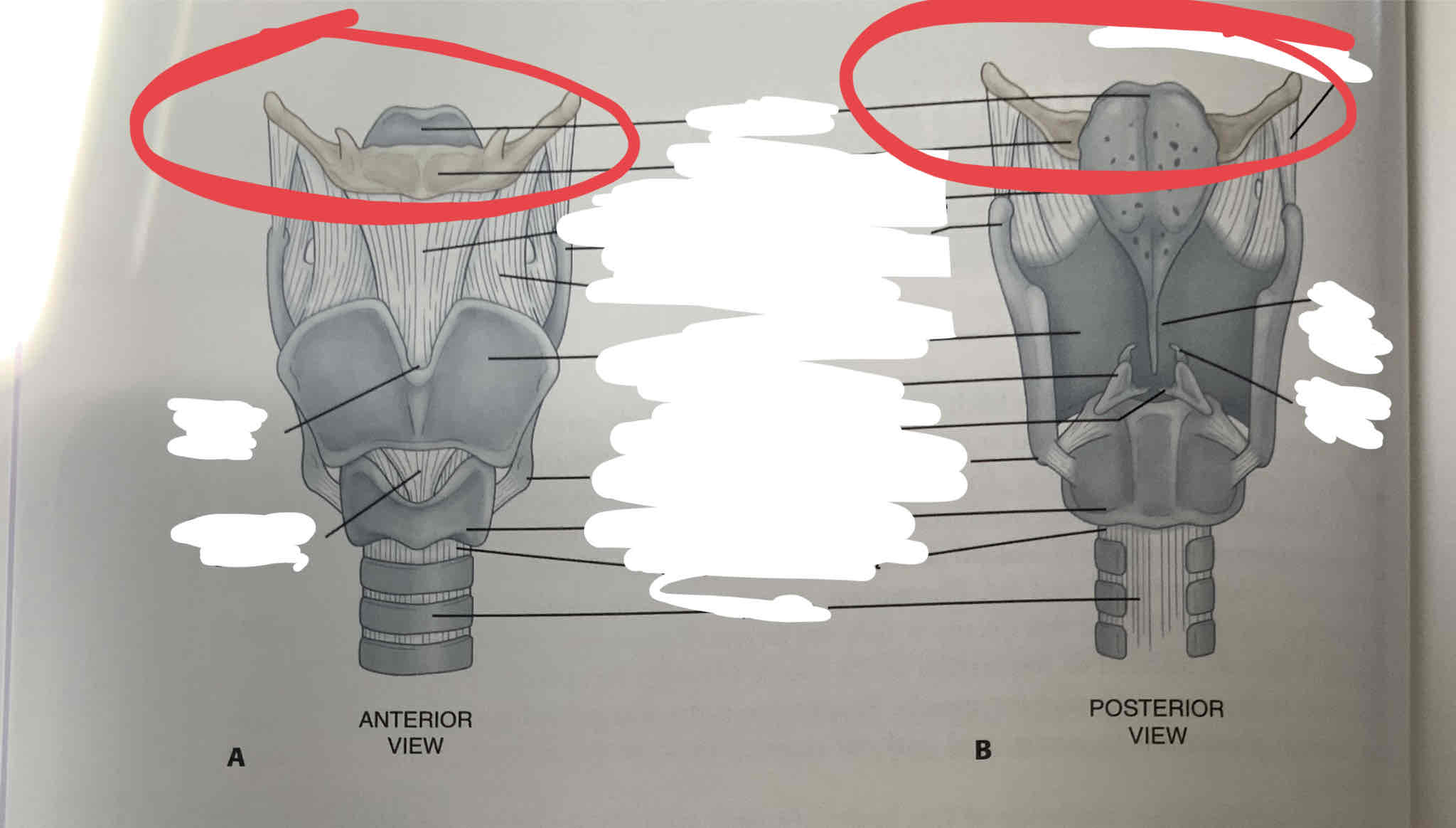
greater cornu
structure of the hyoid bone that articulates with the superior horns (cornu) of thyroid cartilage
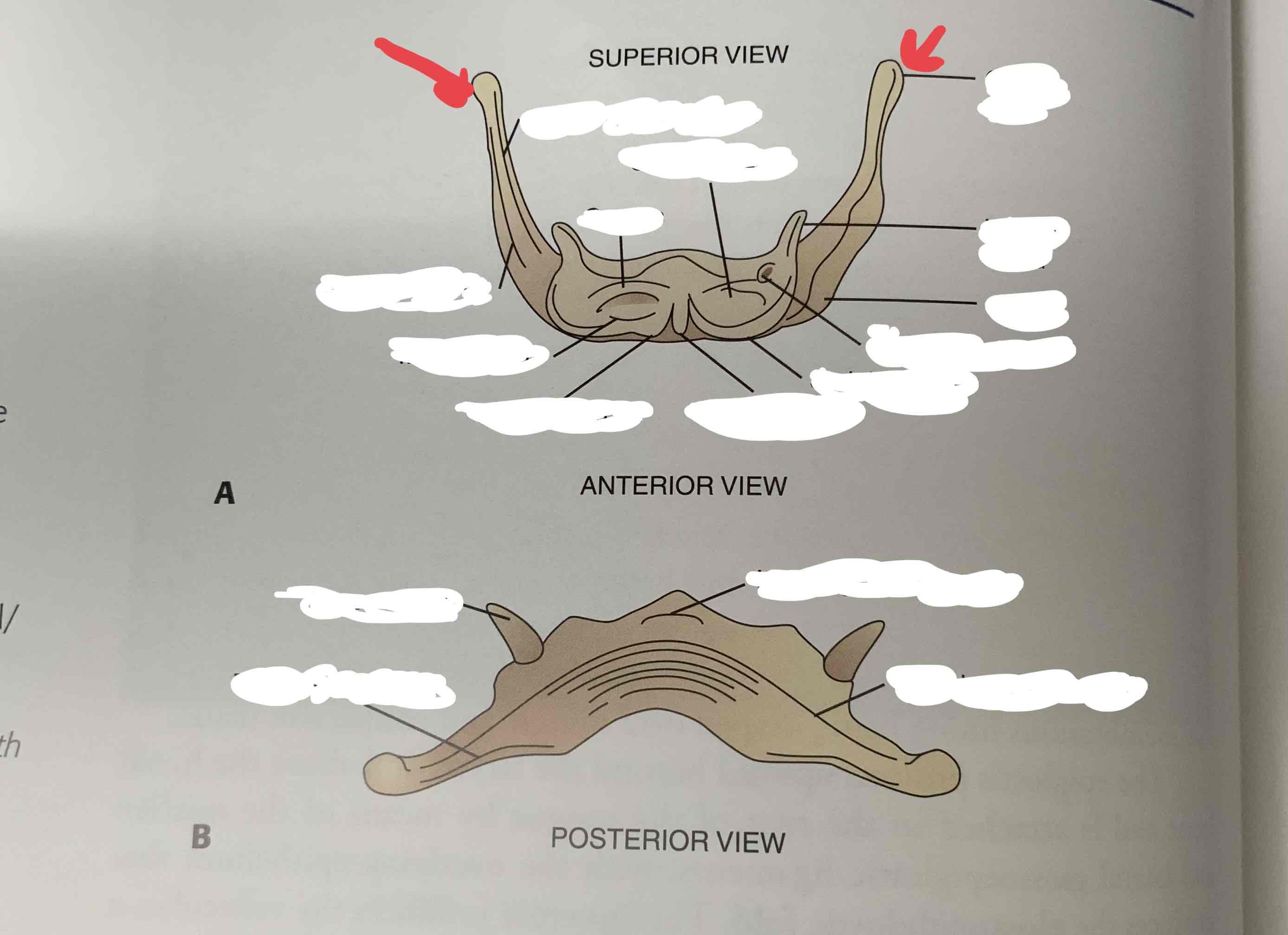
Lesser cornu
structure of the hyoid bone that’s cone shaped; rises superiorly
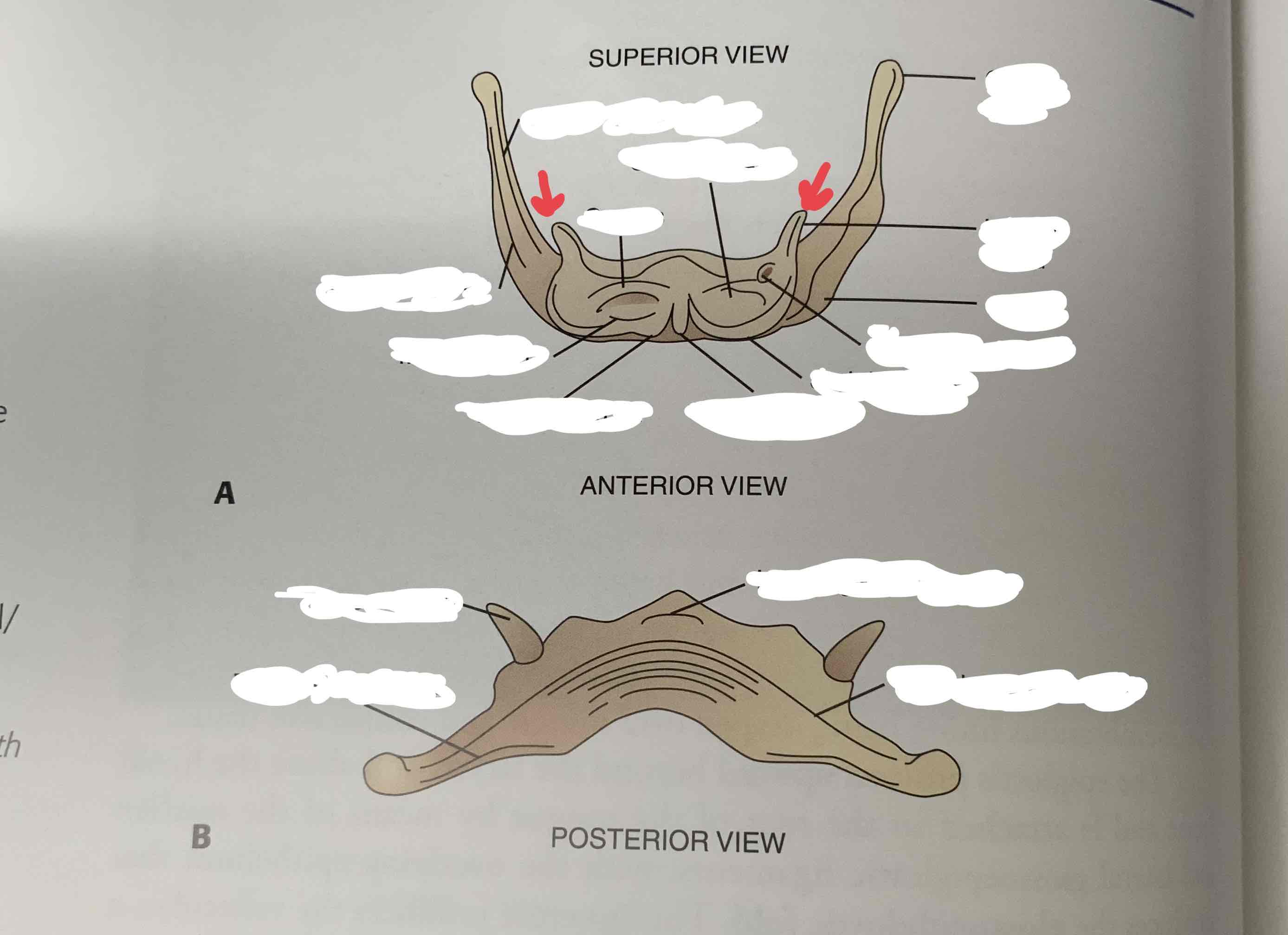
larynx
protects the lower passageway from foreign materials. can be used to hold air in lungs. generates sound
thyroid cartilage
largest of the laryngeal cartilages. articulates inferiorly with cricoid cartilage
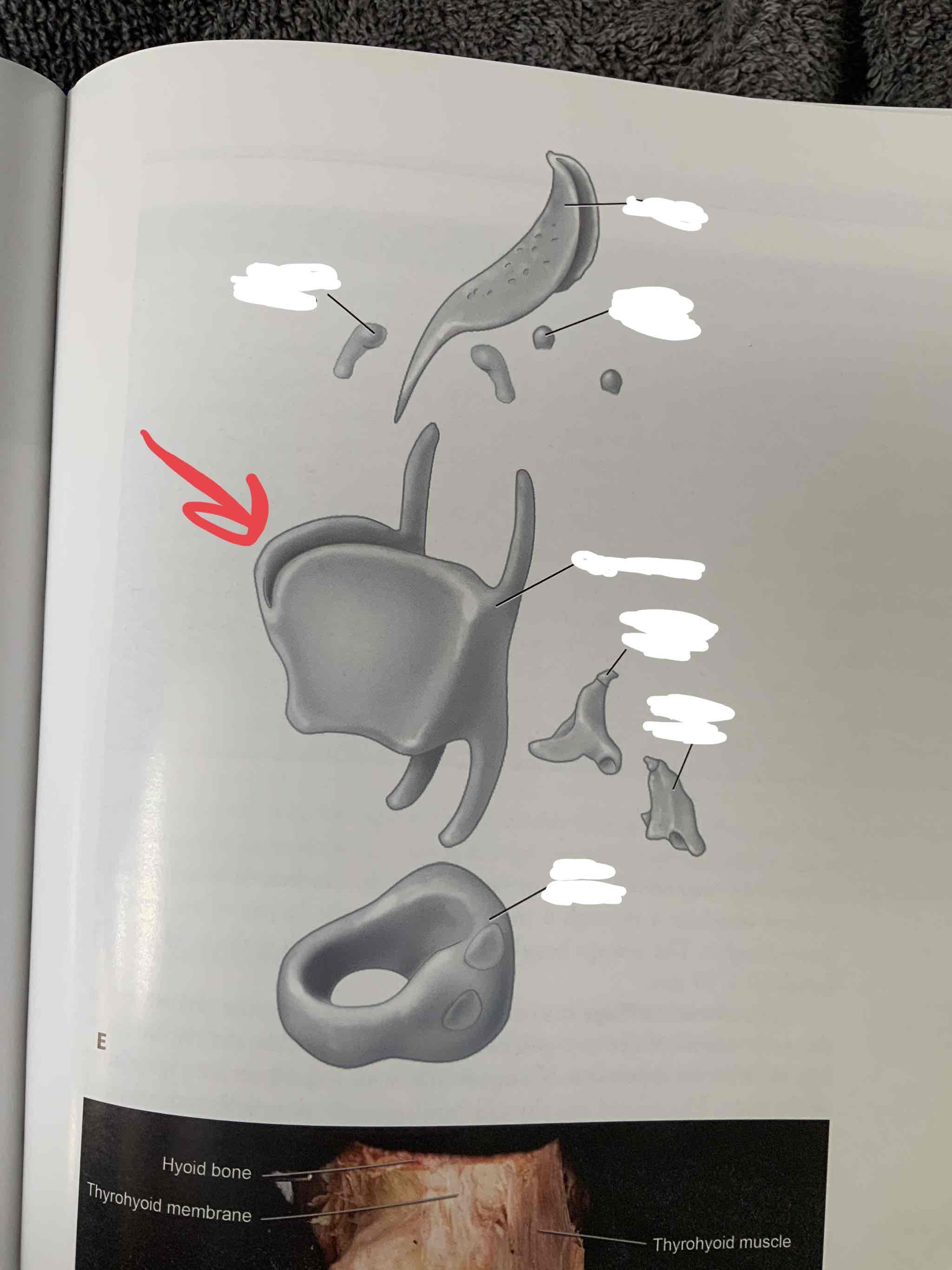
Thyroid Laminae
smooth flattish structure of the thyroid cartilage aka quadrilateral plates
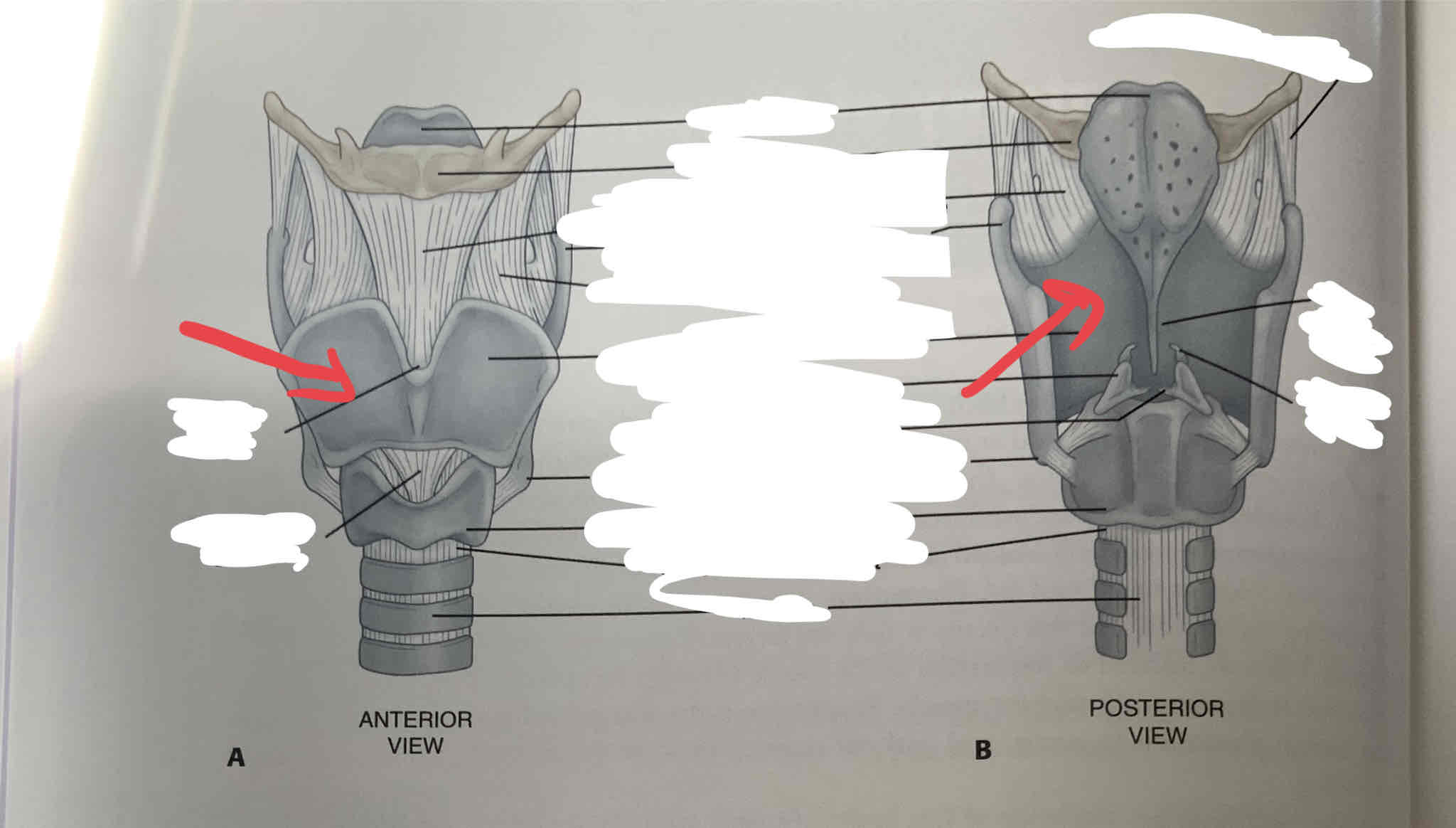
Thyroid angle
point at which the two thyroid laminae come together
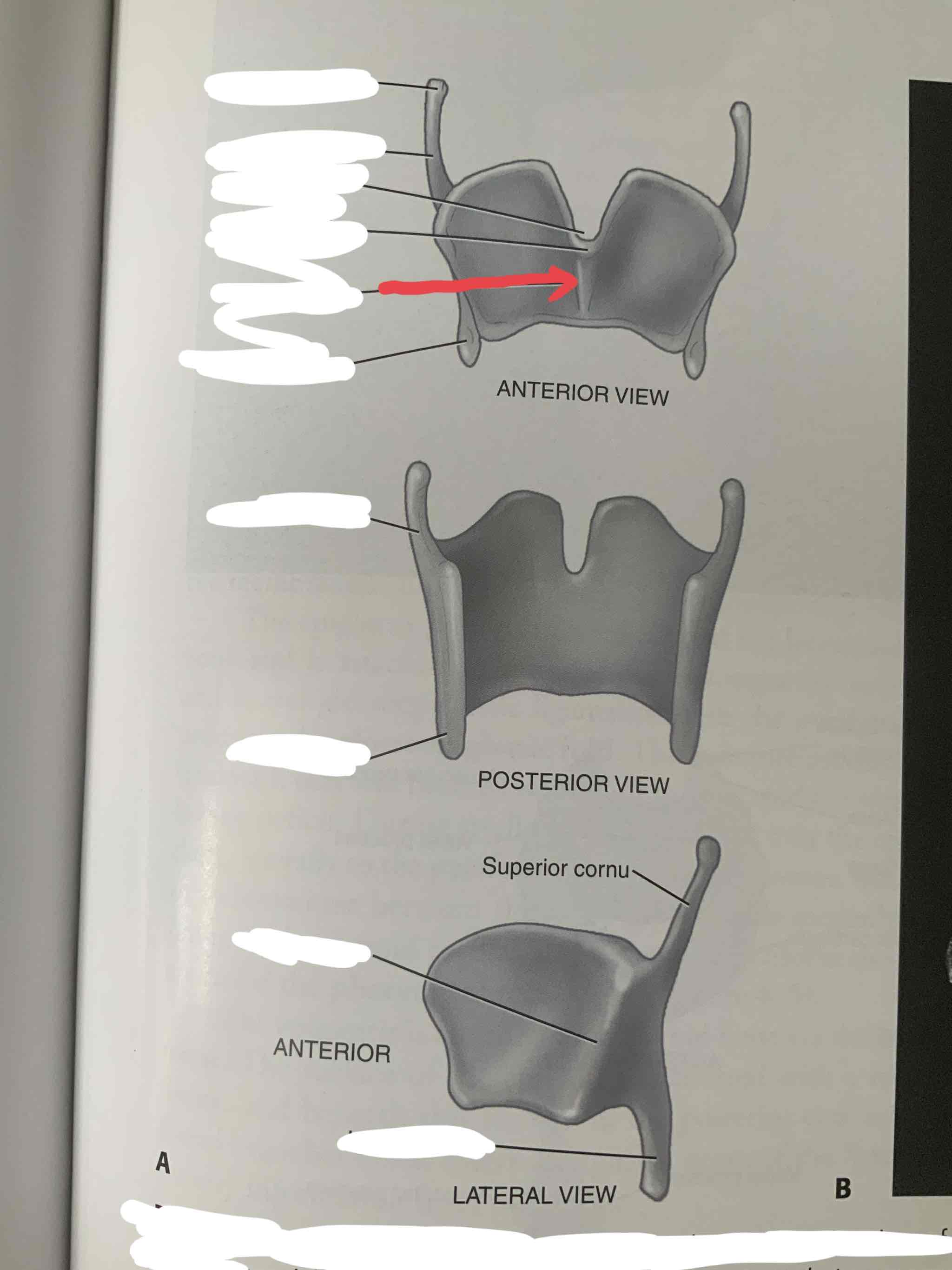
thyroid notch
superior-most point of thyroid angle
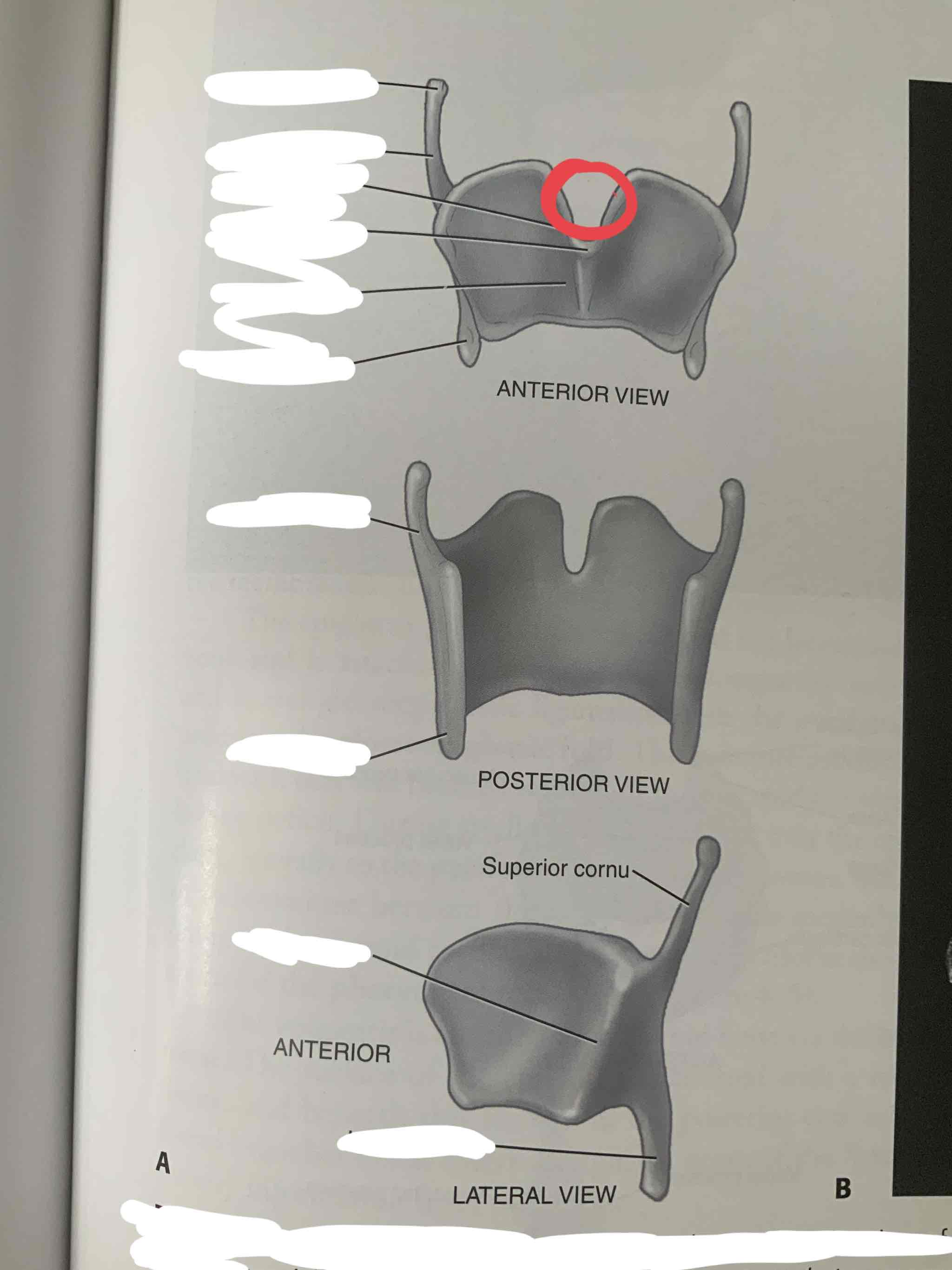
thyroid prominence
“Adam’s Apple”
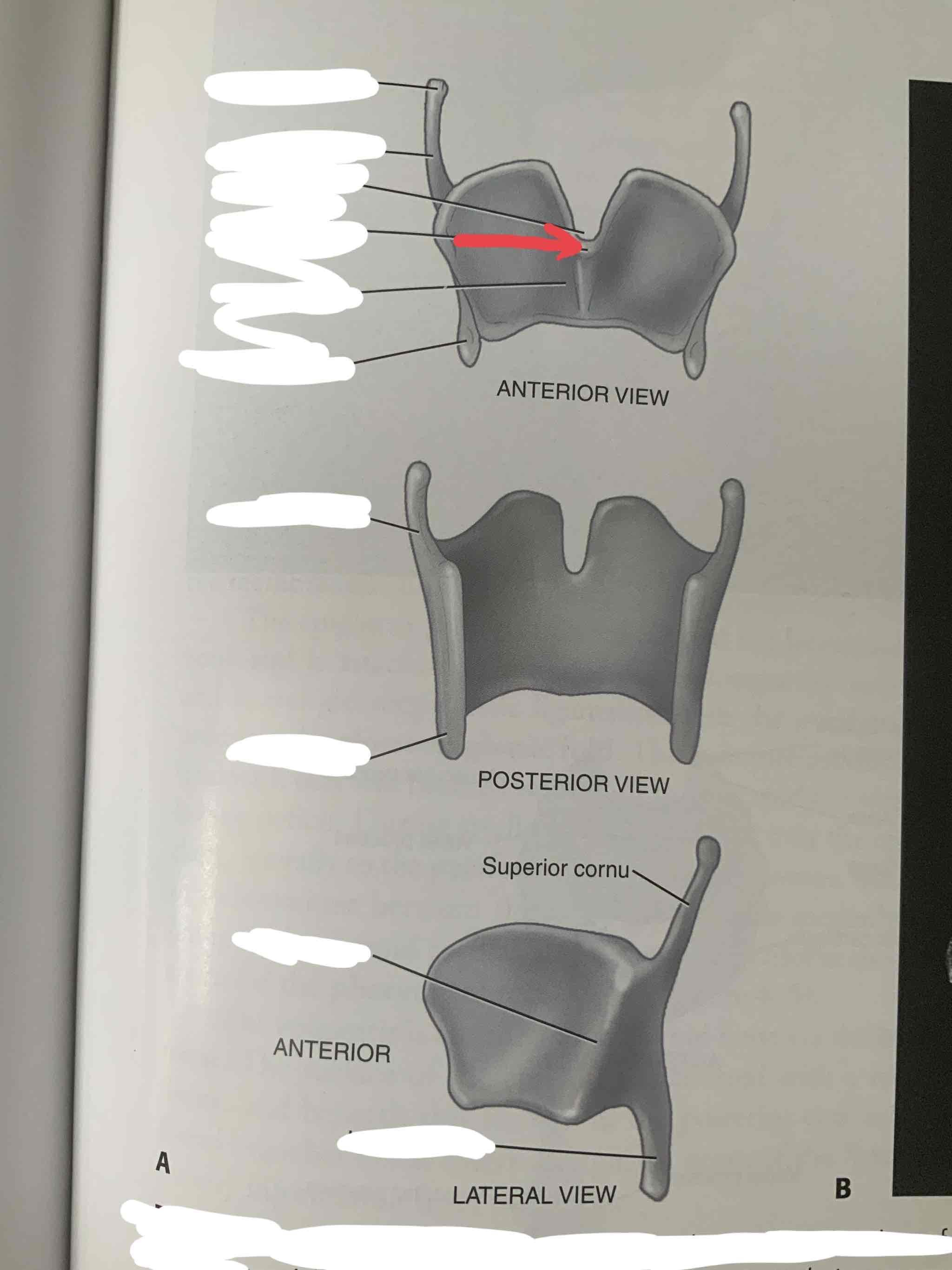
Superior Cornu
located on the posterior portion of thyroid. points toward hyoid bone
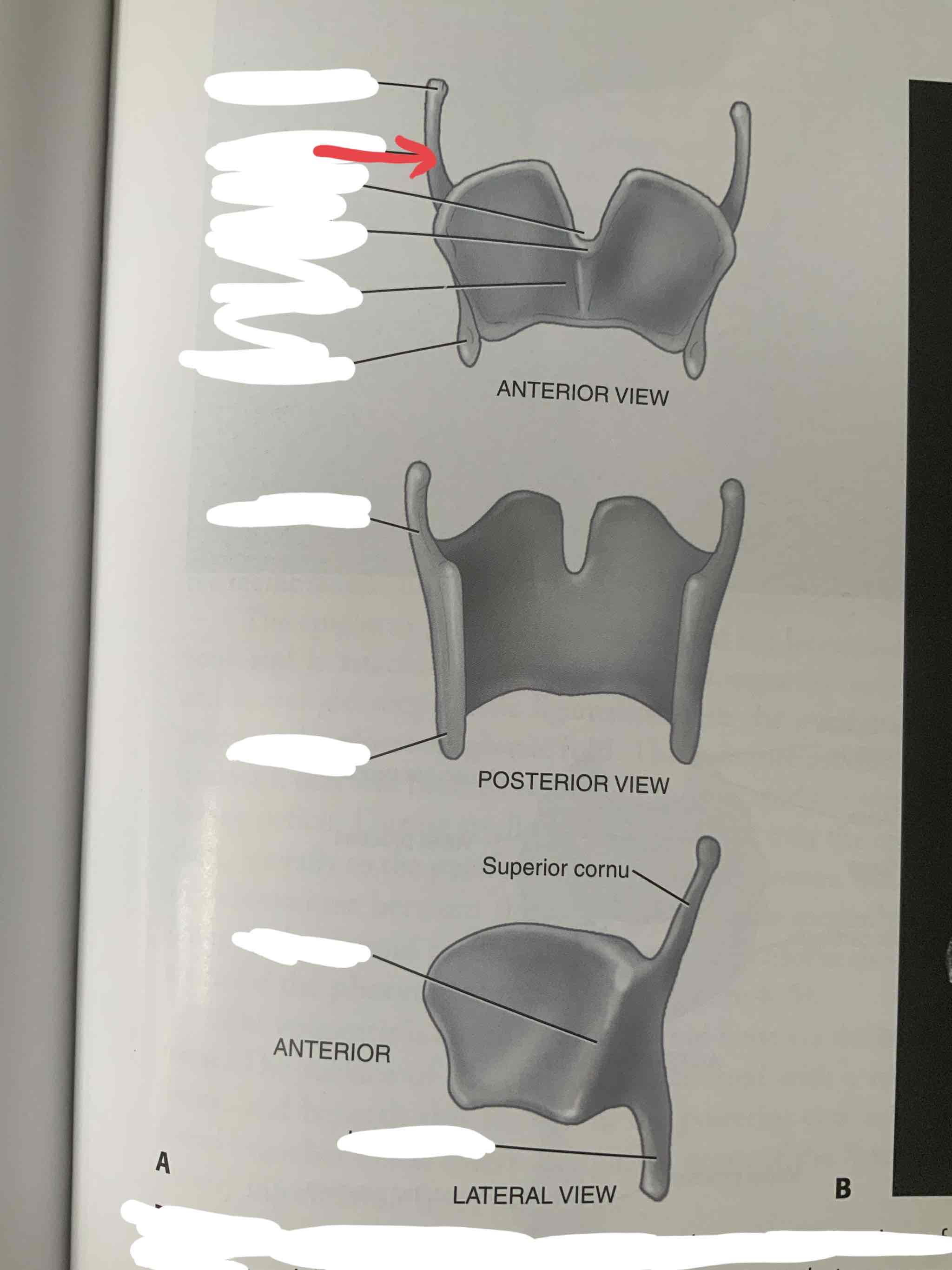
Inferior Cornu
located on the posterior portion of thyroid. Rests on cricoid cartilage
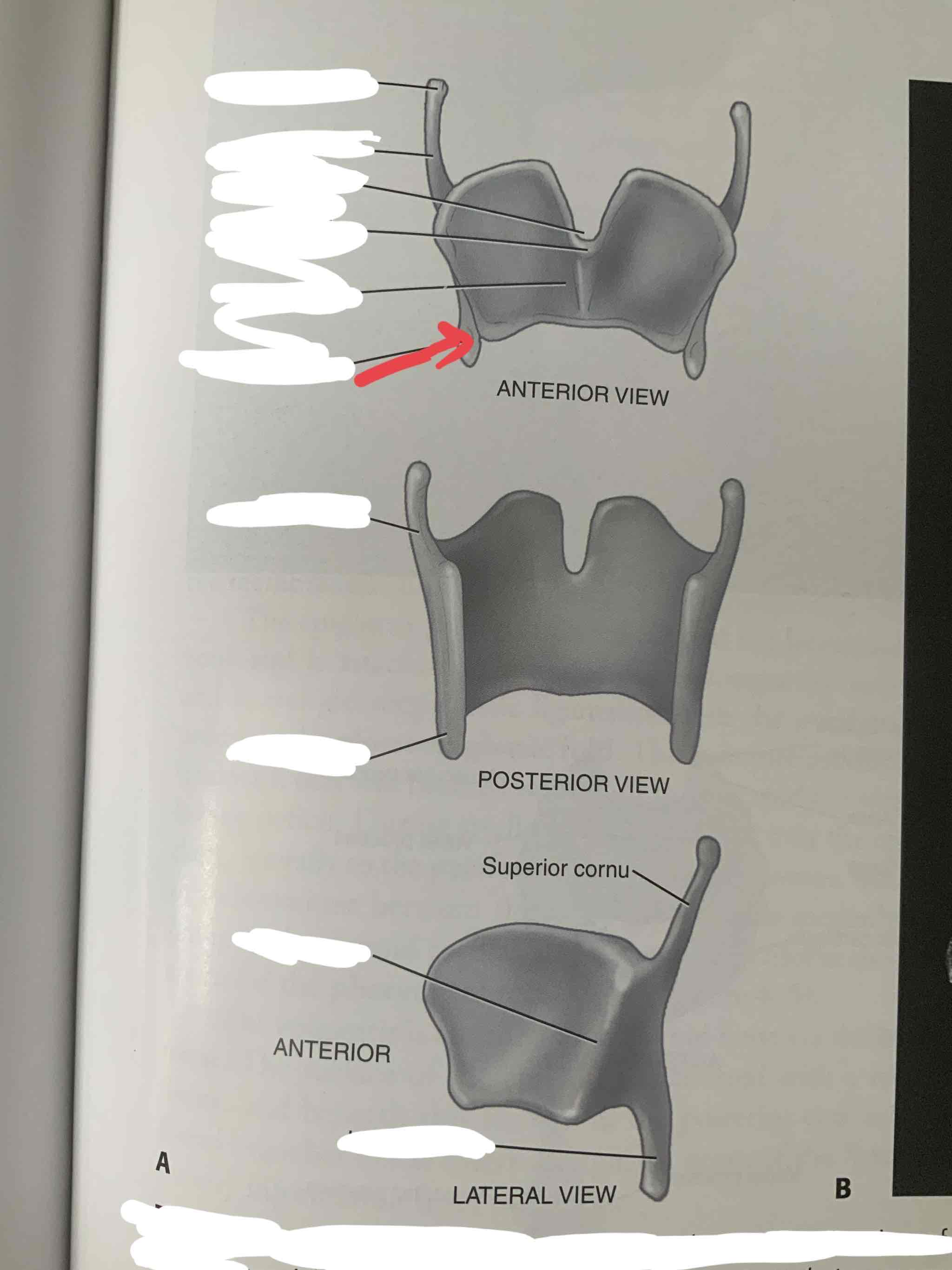
Cricoid Cartilage
most inferior cartilage of larynx. unpaired, ring-shaped

Arch
low narrow portion in the front of cricoid cartilage. provides clearance for the vocal folds
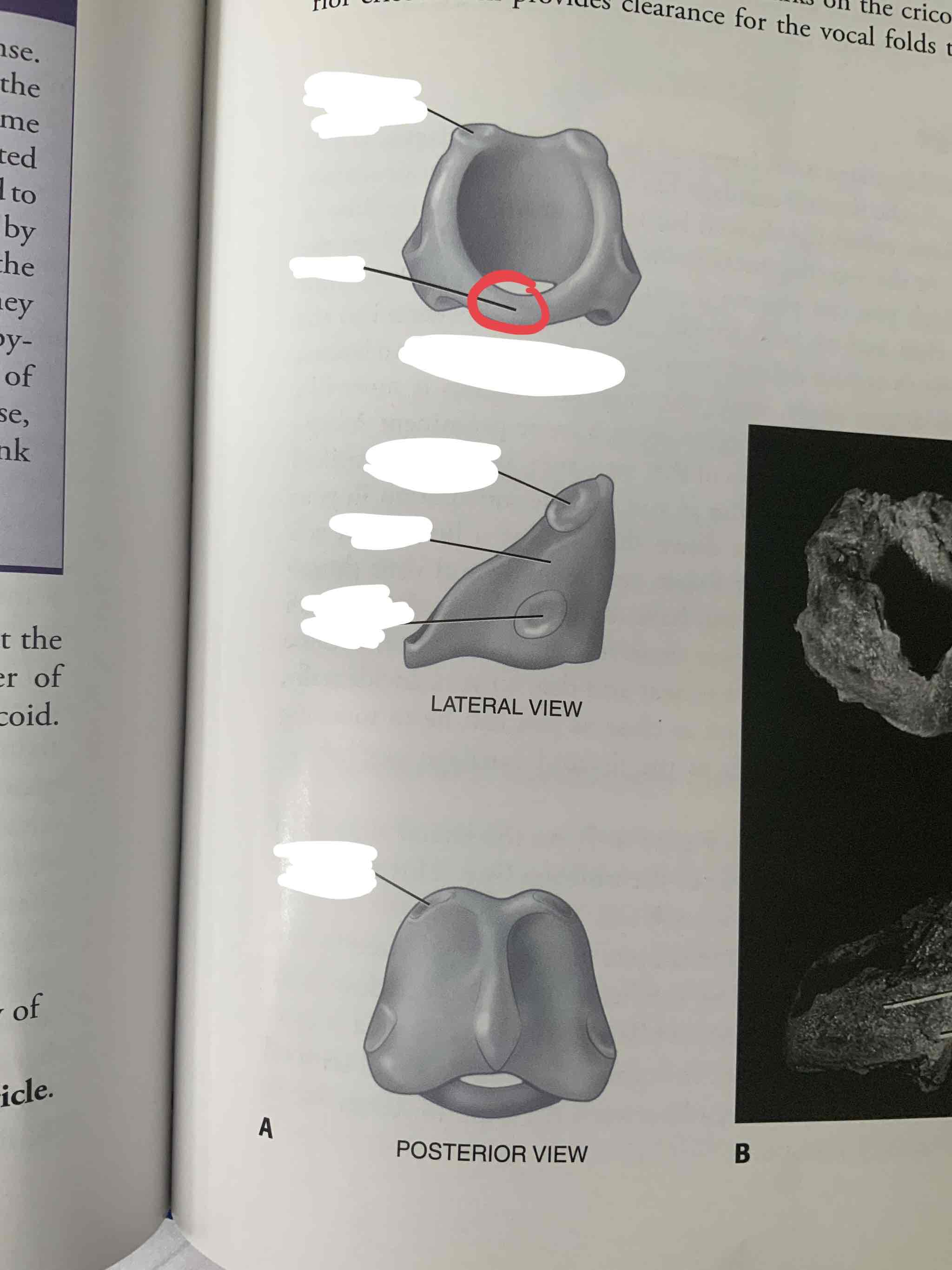
posterior quadrate lamina
wide and thick portion in back of cricoid cartilage. provides point of articulation for arytenoid cartilages
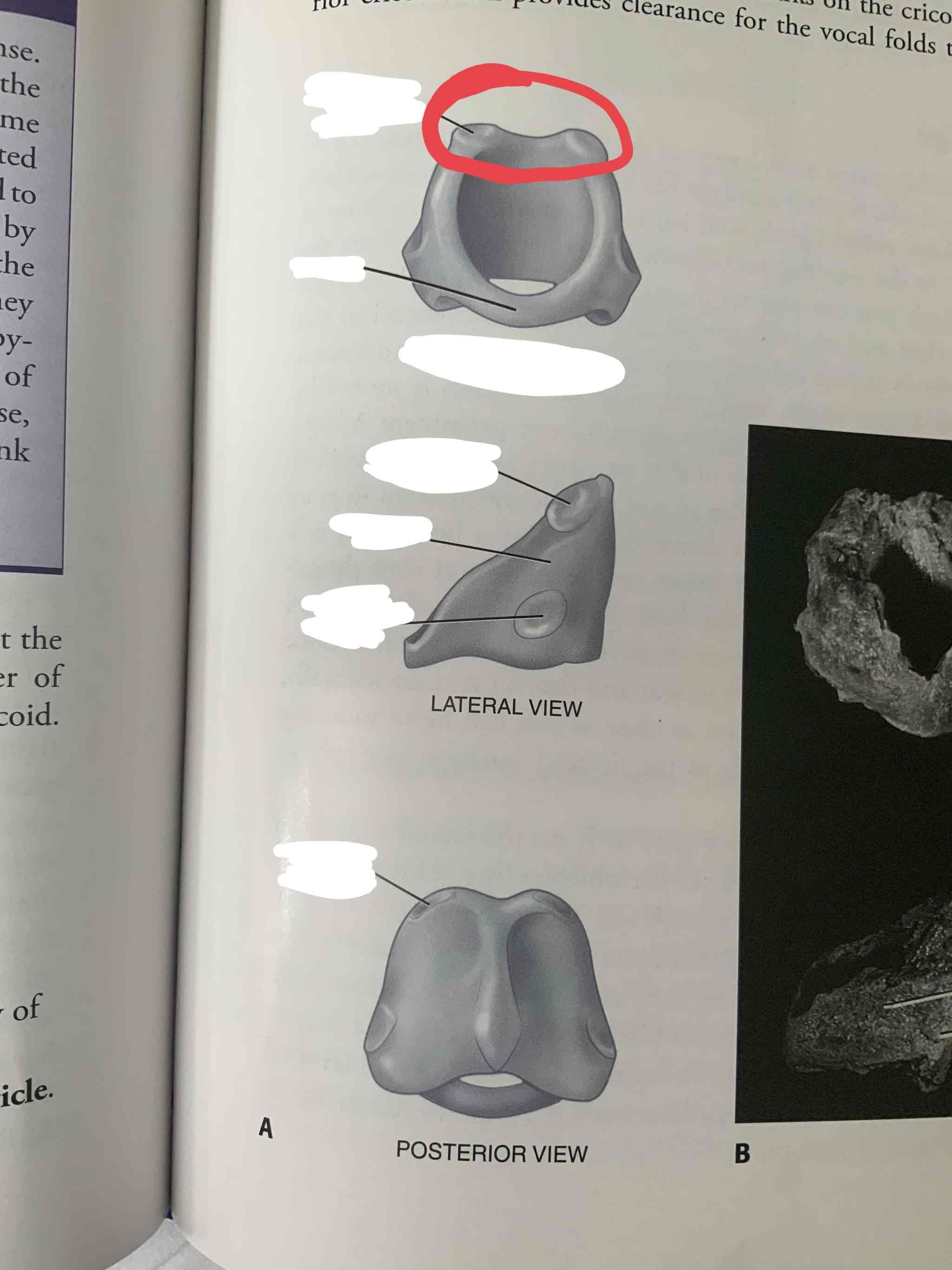
arytenoid cartilages
located on superior surface of cricoid cartilage. allows for rocking, gliding, and rotating (important for onset and offset of voicing). Shaped like a pyramid. comprised of base, apex, vocal process, and muscular process
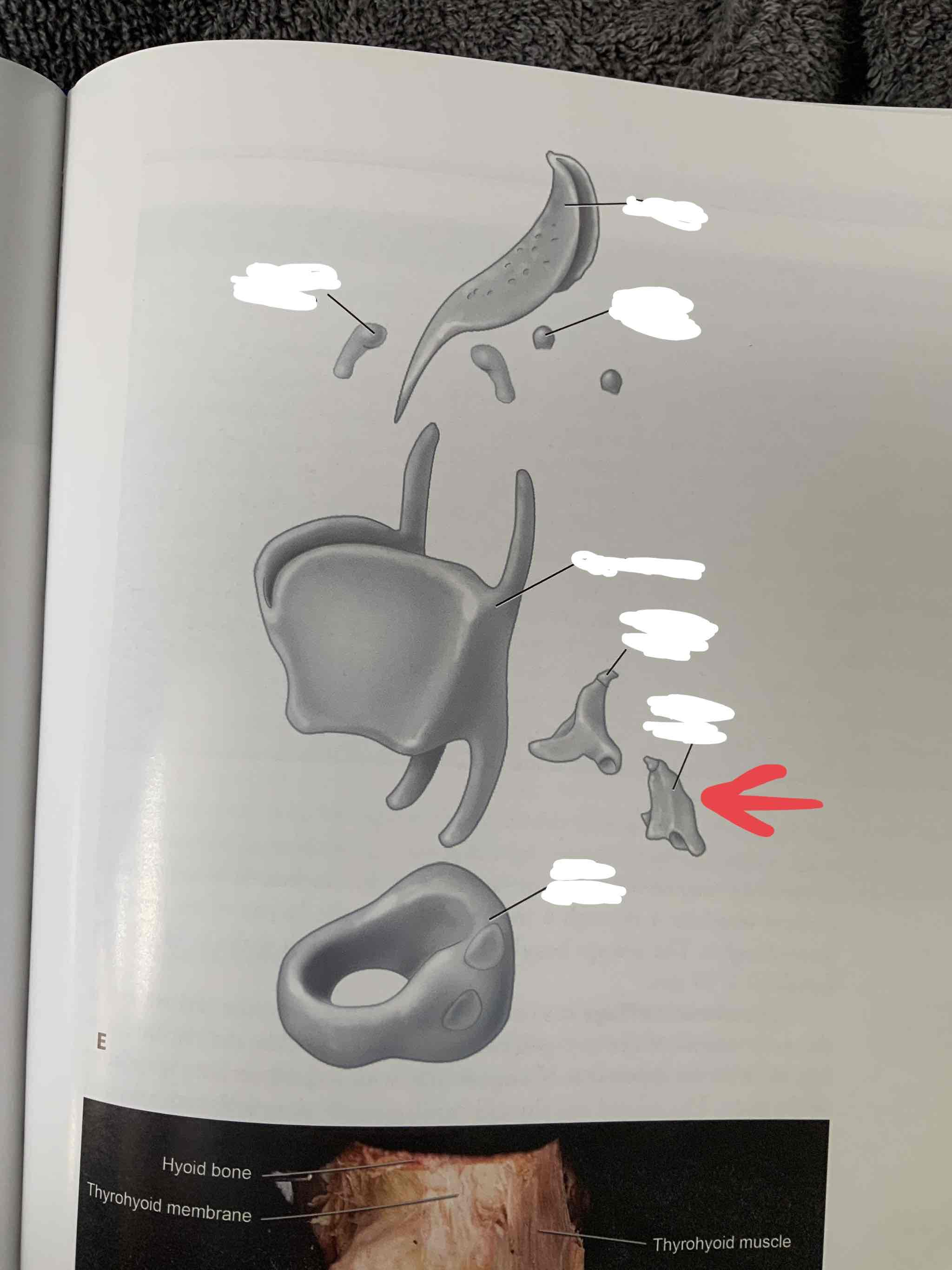
vocal process
structure of arytenoid cartilages that projects anteriorly toward the thyroid notch. location of the vocal fold attachment

muscular process
projects laterally on the arytenoid. point of attachment for muscles that adduct and abduct the vocal folds
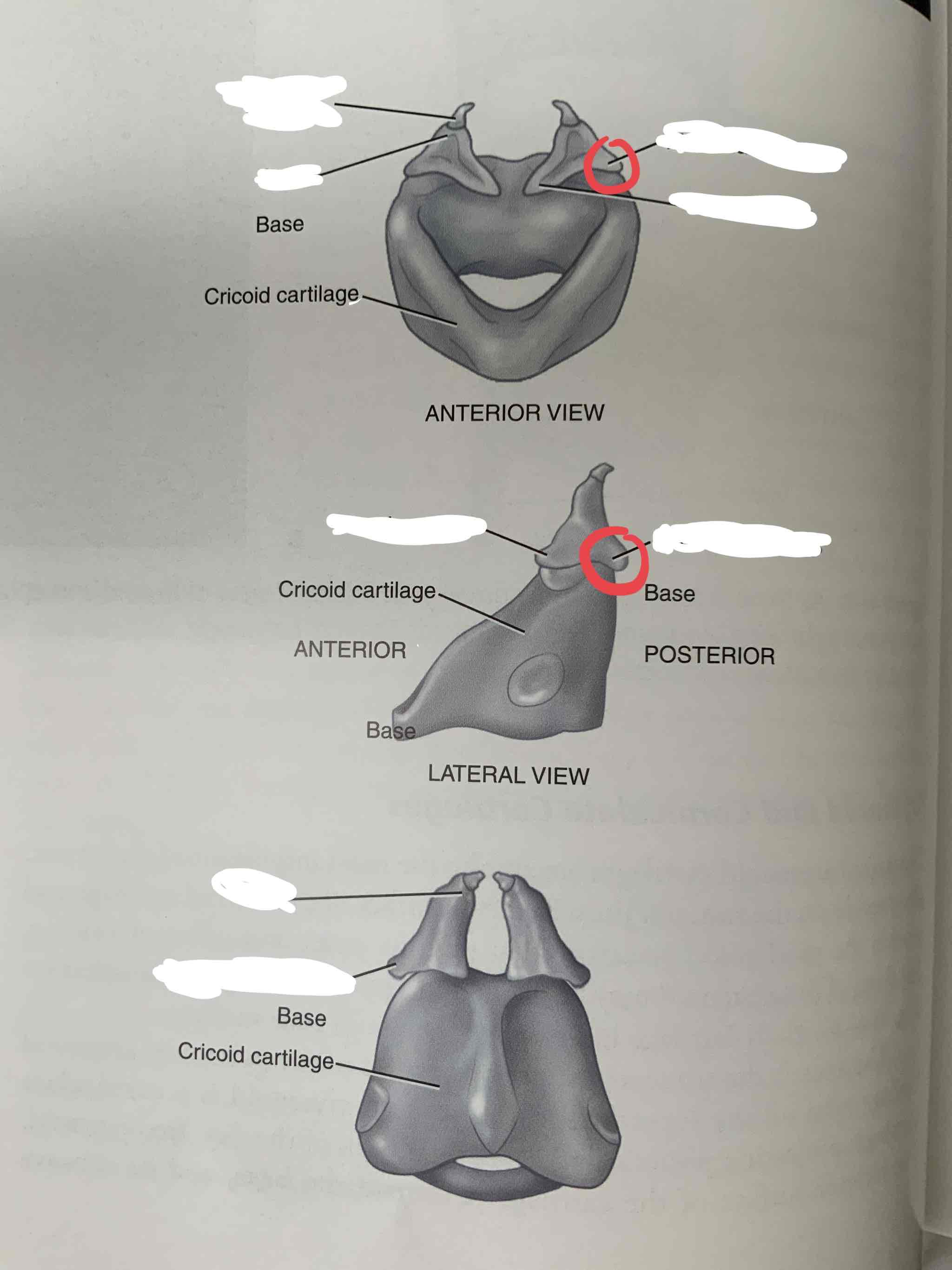
Cuneiform cartilages
small cartilages embedded within the aryepiglottic fold. anterior to corniculate cartilages. provide support for laryngeal covering

Epiglottis Cartilage (Epiglottis)
Leaf-like structure. stem (petiolus) arises from the inner surface of the thyroid angle, just below notch. protects airway by deflecting food and liquids from being swallowed. surface of epiglottis is covered with a mucous membrane lining
cricothyroid joint
laryngeal synovial (darthrodial) joint that allows the thyroid to tilt downward. this stretches and tenses the vocal folds. joint provides the major adjustments for change in vocal pitch. junction between cricoid cartilage and the inferior cornu of thyroid cartilage
cricoarytenoid joint
laryngeal joint. concave portion of arytenoids articulates with convex portion of cricoid lamina (top back of cricoid). synovial joint (saddle joint) allows for rocking, gliding, and minimal rotation involved in adduction and abduction of vocal folds
extrinsic laryngeal membranes and ligaments
group of ligaments and membranes that connect the cartilages of the larynx to each other and to the hyoid bone and trachea
thyrohyoid membrane (hyothyroid)
connects hyoid bone to thyroid cartilage

hypoepiglottic ligament
connects epiglottis to the hyoid bone
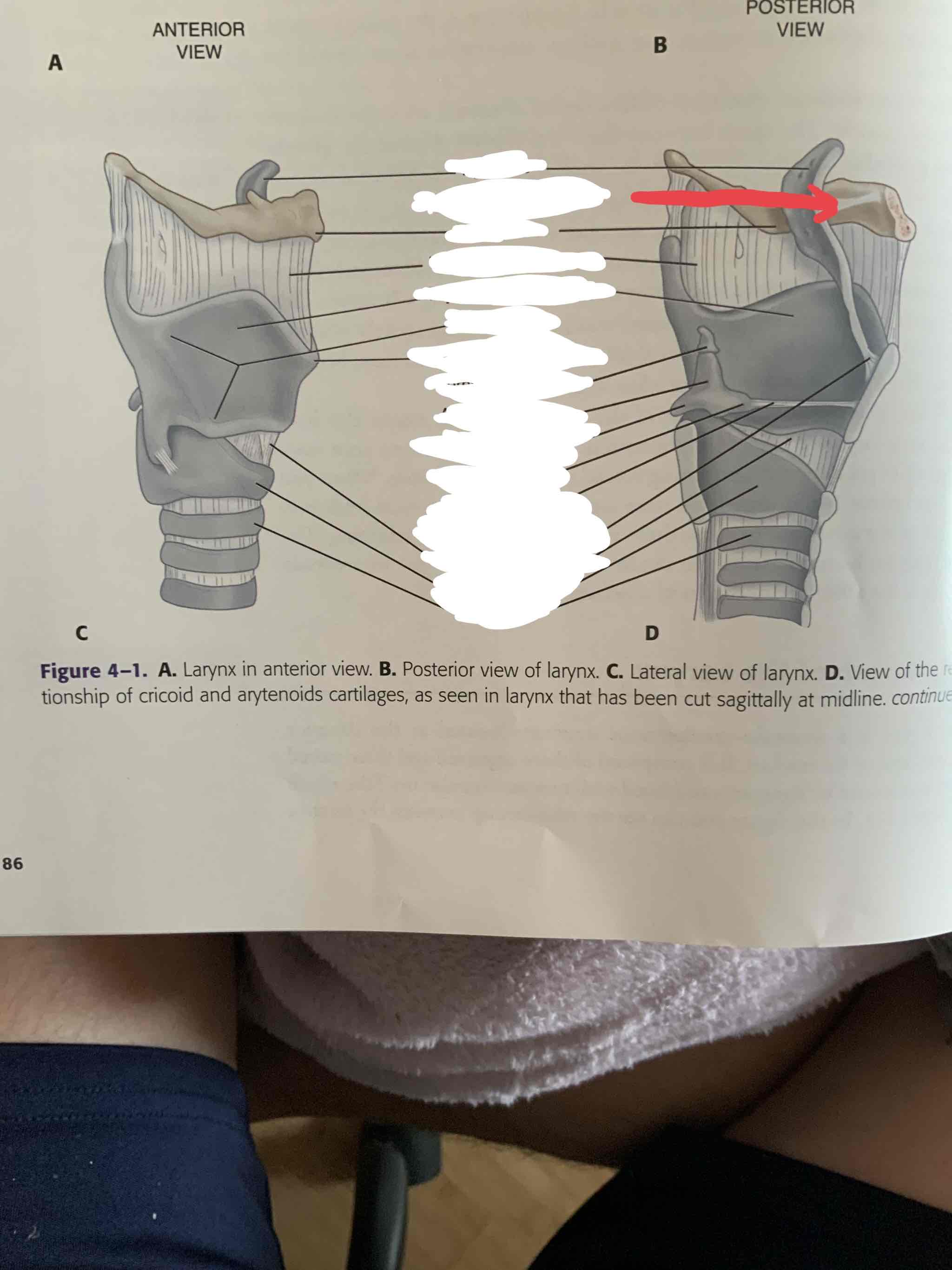
thyroepiglottic ligament
connects the epiglottis to the thyroid
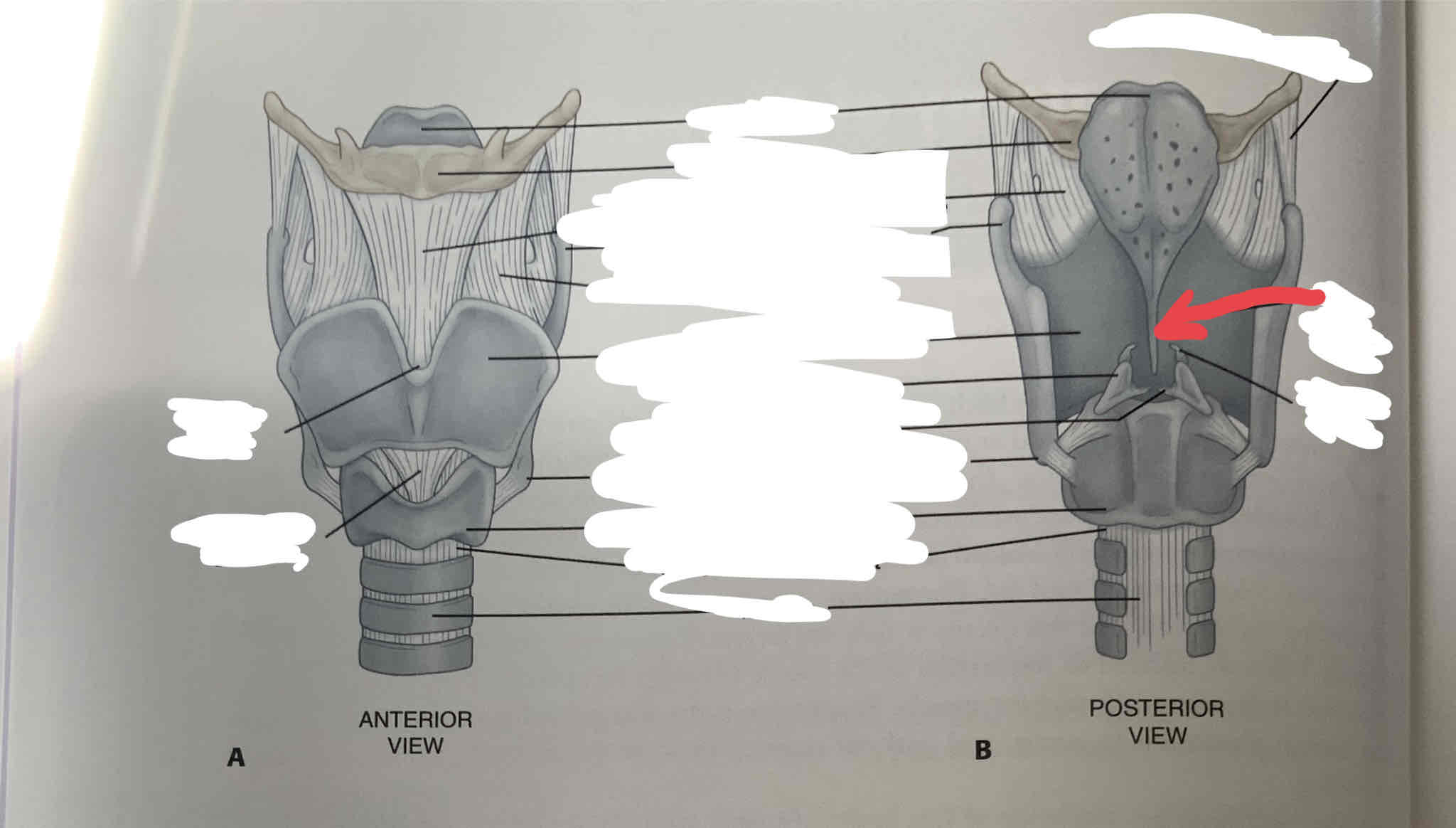
cricotracheal membrane
connects the cricoid cartilage to the first tracheal ring

intrinsic laryngeal membranes and ligaments
continuous sheet of connective tissue (elastic membrane)
aryepiglottic folds
quadrangular membrane (upper portion) that completely seals off the spaces in the laryngeal structure. directs the airstream into the aditus and upward into the resonators passageways. first line of defense against foreign objects. closes during swallowing and vomiting (prevents food/liquid from entering respiratory tract)
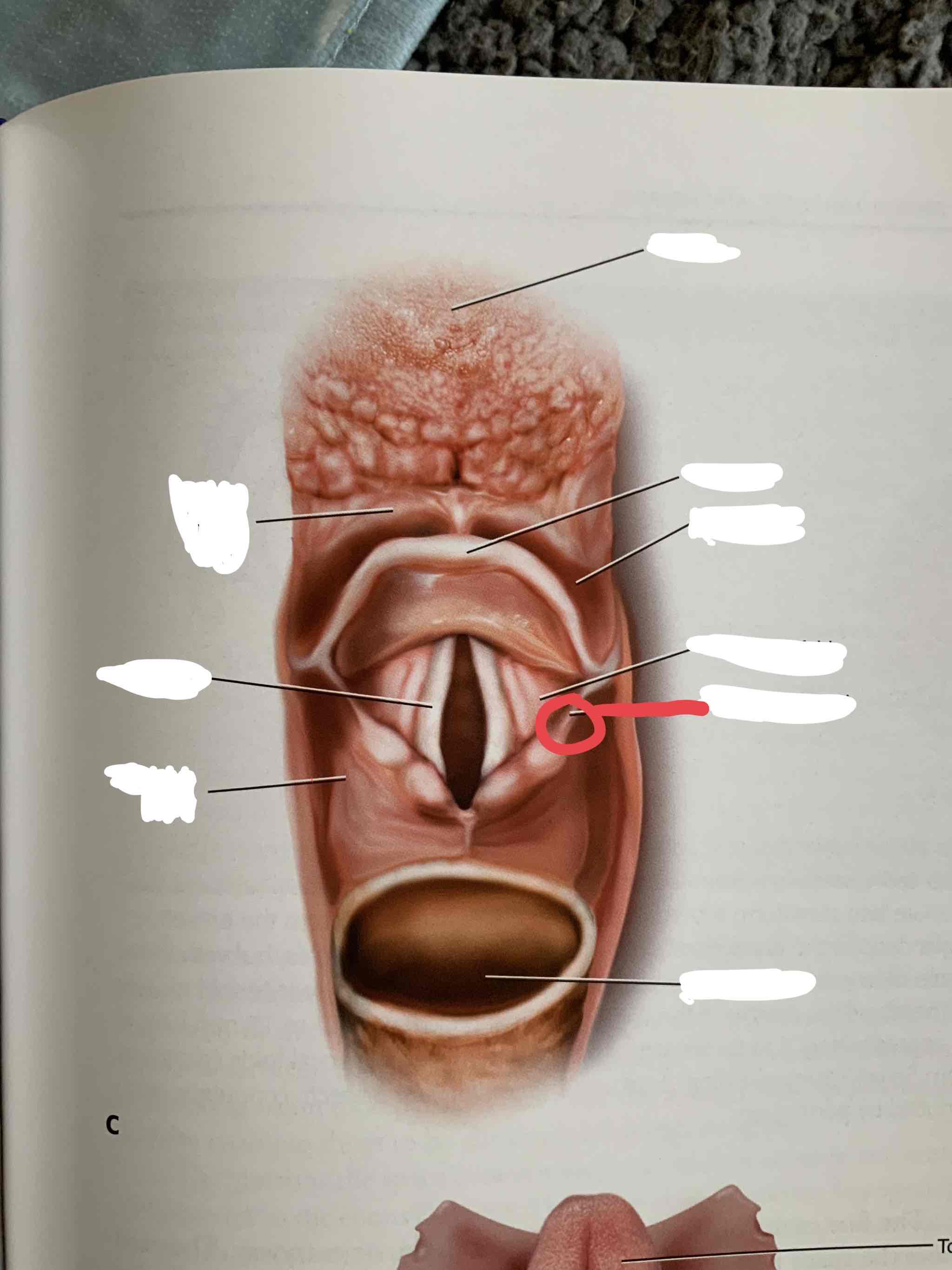
ventricular folds
aka false vocal folds. pink and plump. quadrangular membrane (upper portion) found between laryngeal vestibule and laryngeal ventricle. when these contract, they meet at midline, closing and sealing off the airway. close during swallowing, and during effortful activities such as lifting heavy objects. during normal phonation, these remain in quiet, open position
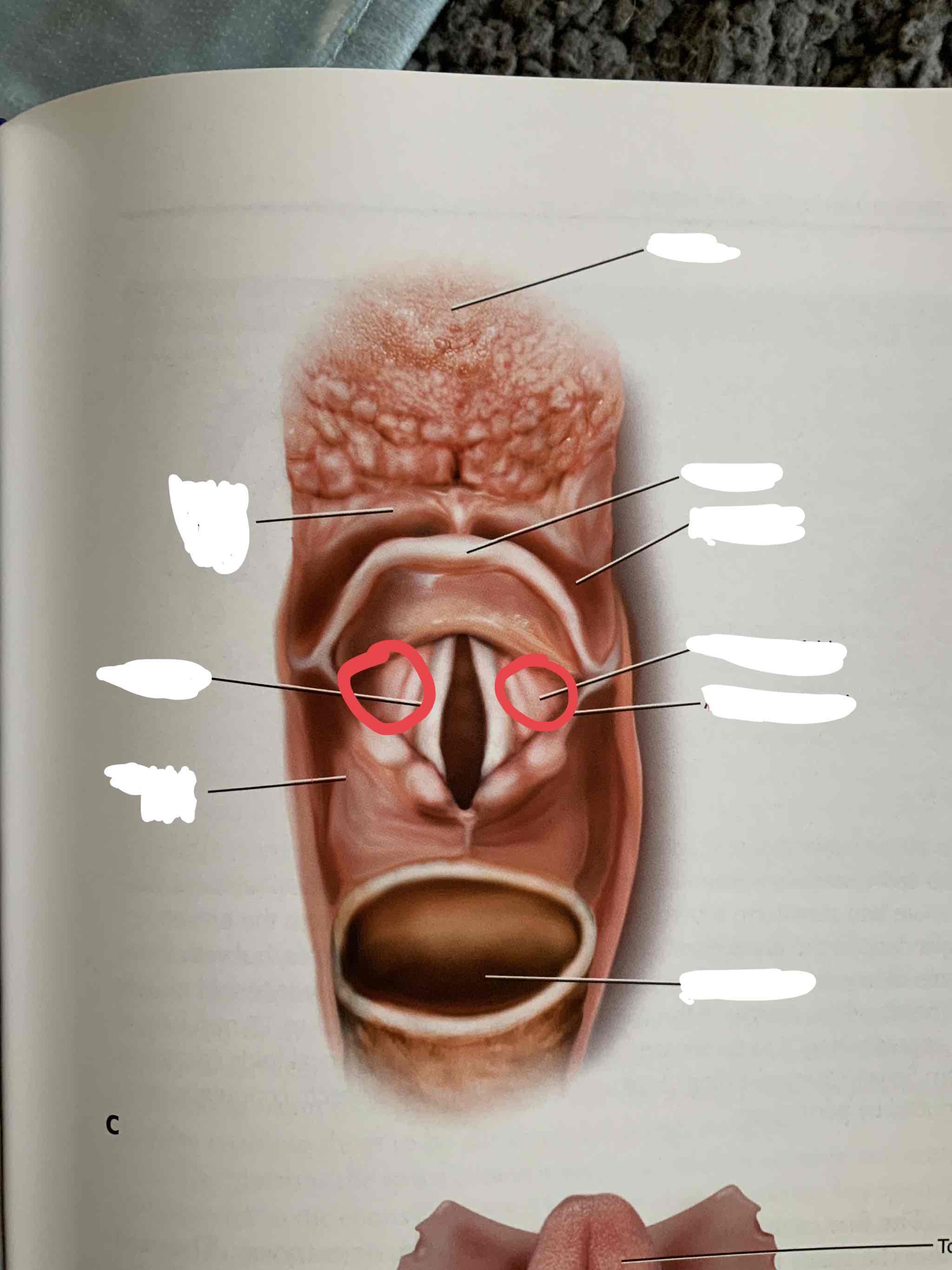
vocal folds
conus elasticus (lower portion) that’s white from lack of vascular supply. third line of defense in keeping foreign objects out of lungs
cricothyroid ligament
conus elasticus (lower portion) that connects the cricoid cartilage to the thyroid cartilage
laryngeal vestibule
first cavity of the larynx. area in larynx above ventricular folds. opening is called aditus
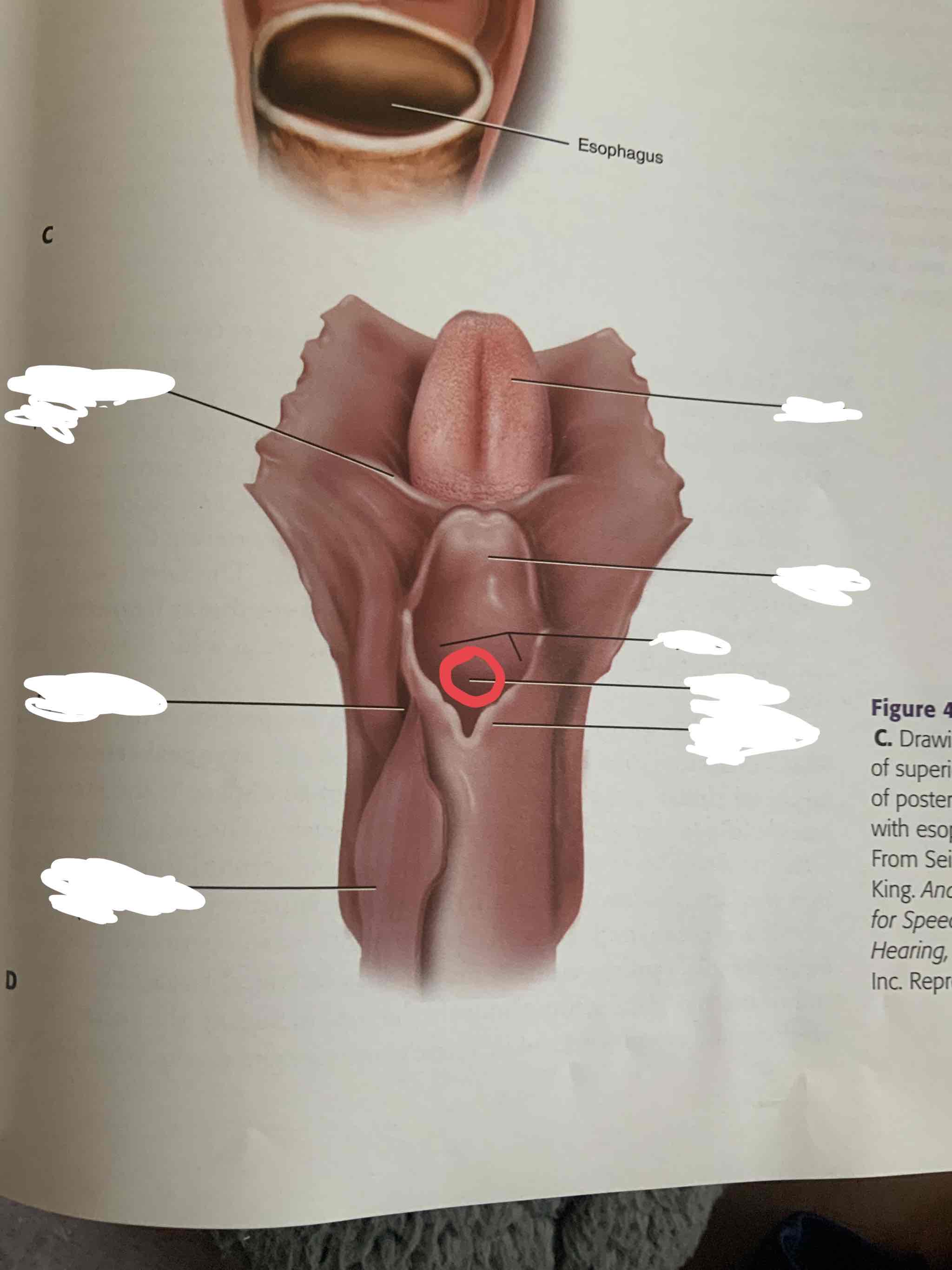
laryngeal ventricle
space between vocal folds and ventricular folds
inferior laryngeal ventricle (subglottal atrium)
portion below the true folds. extend through to the trachea
valleculae
area between tongue root and epiglottis. impaired swallow can cause food/liquid to pool in this area which increases risk for aspiration
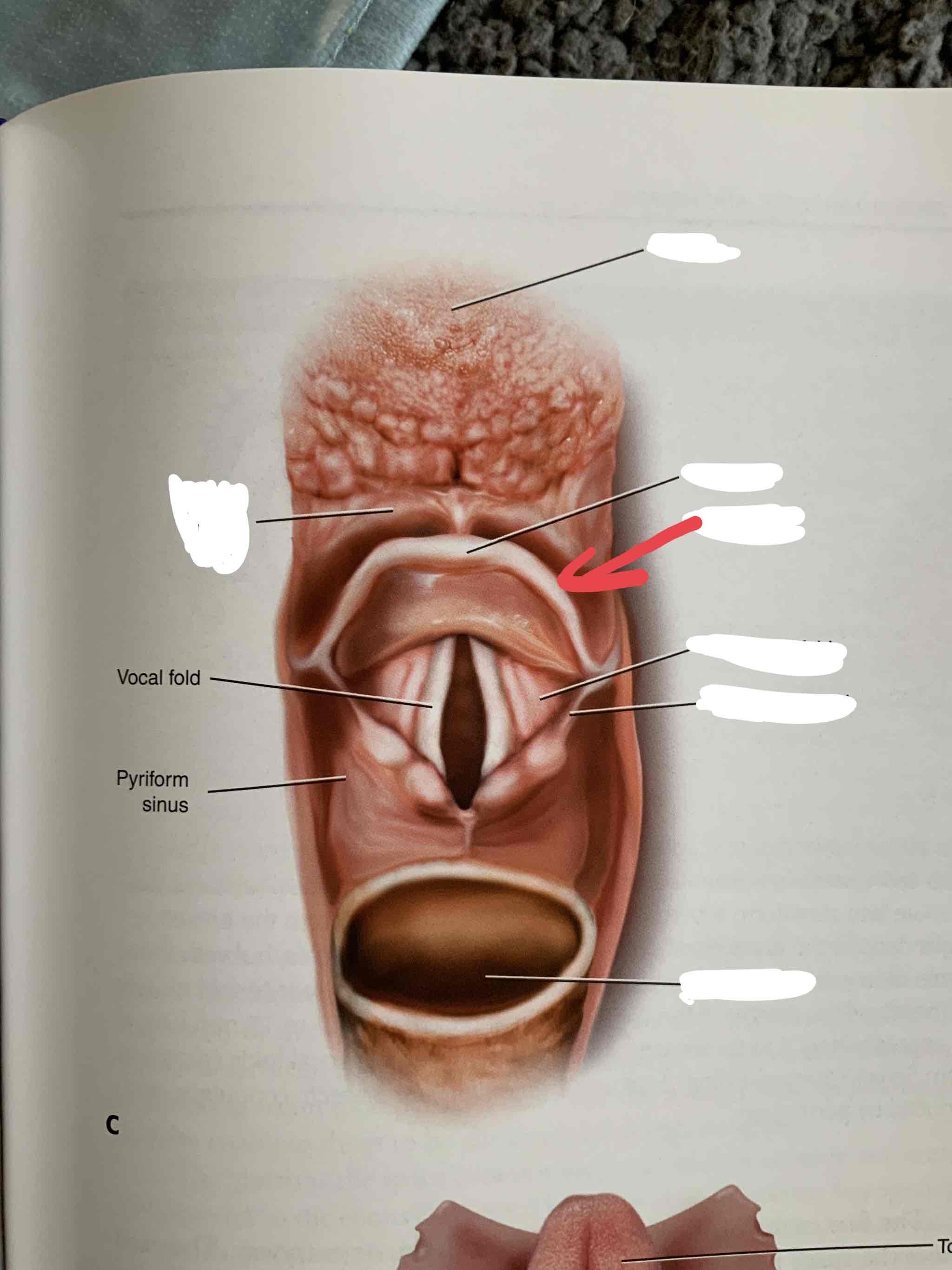
pyriform sinus
between the lateral wall of thyroid cartilage and aryepiglotic folds. impaired swallow can cause food/liquid to pool in pyriform sinus which increases risk for aspiration
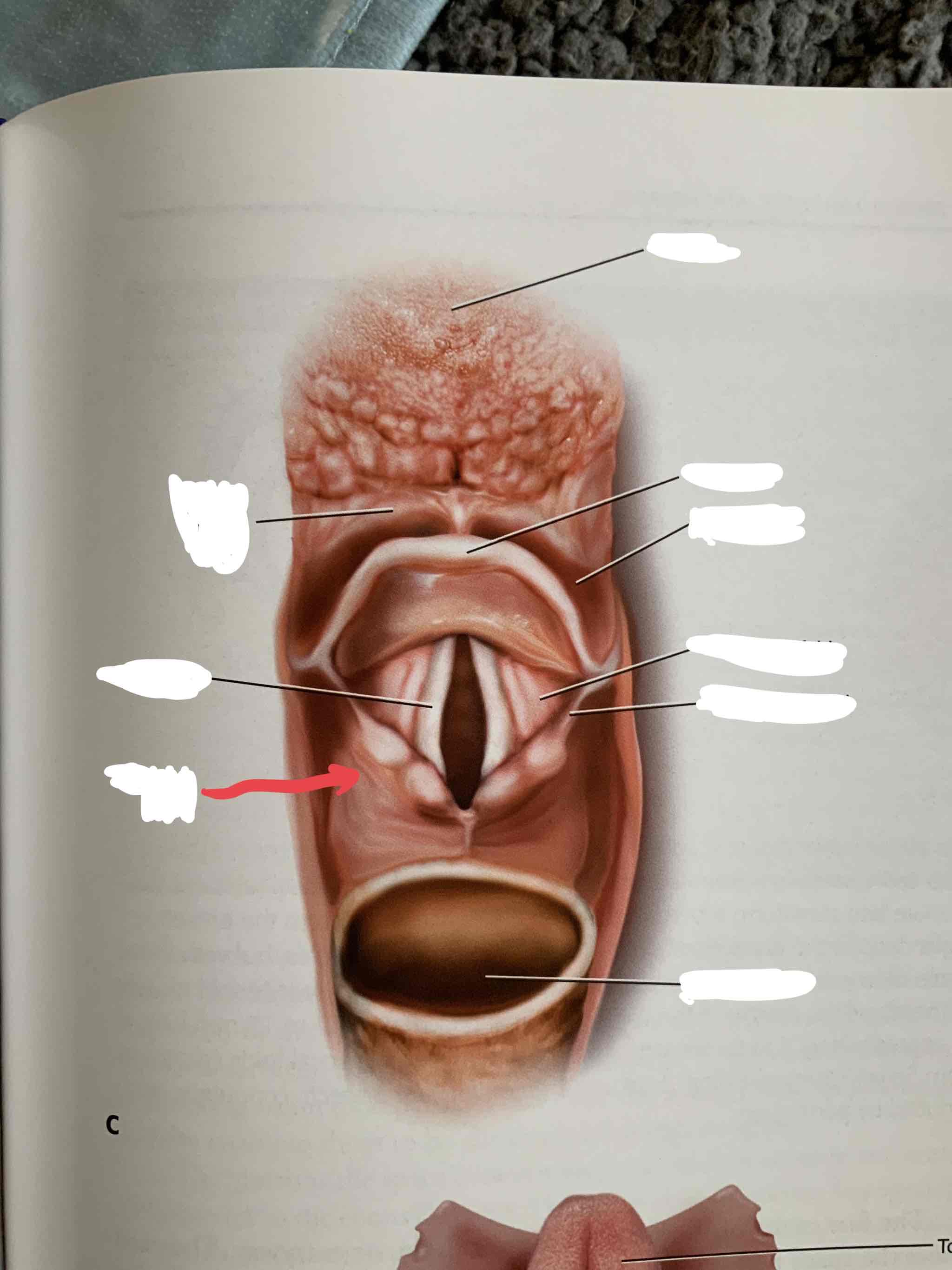
glottis
opening between vocal folds. triangular shape during quiet respiration
anterior commissure
the anterior-most region of the glottis
posterior commissure
the posterior-most region of the glottis
epithelium
cover layer of the vocal folds. mucosal covering of stratified squamous cells. needs a thin layer of mucous lubrication for best oscillation
superficial lamina propria (Reinke’s Space)
cover layer of vocal folds. extracellular gelatin matrix. helps cushion the vocal cords
intermediate lamina propria
transition/vocal ligament composed of elastic fibers. part of the vocal ligament
deep lamina propria
transition/vocal ligament composed of collagen fibers. supportive, part of vocal ligament
thyroarytenoid
body layer of the vocal folds. thyrovocalis + thyromuscularis. provides tone, stability and mass
laryngeal musculature
regulates valve openings and closings for the epiglottis valv , ventricular fold valve, and vocal fold valve. provides movement of laryngeal cartilages for speech
intrinsic laryngeal muscles
have both origin and insertion within larynx. make fine adjustments to the vocal mechanism
lateral cricoarytenoid muscle
intrinsic muscle. adducts the vocal folds
transverse arytenoid muscle
only unpaired intrinsic muscle. adducts vocal folds
oblique arytenoid muscle
intrinsic muscle. adducts vocal folds (how tightly VF are pressed against each other), rocks arytenoid and vocal folds down and inward
posterior cricoarytenoid muscle
intrinsic muscle that abducts vocal folds
cricothyroid muscle
primary tensor (tightens muscles) of the vocal folds. responsible for laryngeal adjustments associated with pitch change
pars oblique
cricothyroid muscle that rotates thyroid cartilage downward, stretches vocal folds
thyrovocalis muscle
part of thyroarytenoid. body of vocal folds and tenses vocal folds
thyromuscularis muscle
part of thyroarytenoid. relaxer muscle that shortens and relaxes vocal folds
extrinsic muscles
muscles with one attachment to the larynx and the other attachment on a structure outside the larynx. forms a network that surrounds the larynx and anchors it in position within the neck. elevates and depresses parts of the larynx
digastricus muscles (anterior and posterior)
“2 bellies”. extrinsic muscles that elevate hyoid anteriorly and posteriorly respectively. mandible to hyoid bone (anterior), mastoid process to hyoid (posterior)
stylohyoid muscle
extrinsic muscle that elevates hyoid posteriorly. styloid process (side of skull by ear) to hyoid
mylohyoid muscle
extrinsic muscle that makes up the floor of oral cavity. elevates hyoid anteriorly. molar area to hyoid
geniohyoid muscle
extrinsic muscle that elevates hyoid anteriorly. chin to hyoid
genioglossus muscle
extrinsic muscle that forms the primary muscle of the tongue. elevates hyoid. chin to tongue
hypoglossus muscle
extrinsic muscle that elevates hyoid and depresses tongue. hyoid to sides of tongue
Sternohyoid muscle
extrinsic muscle that depresses hyoid. sternum to hyoid
omohyoid muscles (superior and inferior)
extrinsic muscle that depresses hyoid. scapula to hyoid
sternothyroid muscle
extrinsic muscle that assists with producing high and low pitch. helps make fine adjustments to vocal folds. depresses thyroid cartilage, elongating vocal folds. sternum to thyroid
thyrohyoid muscle
extrinsic muscle that depresses hyoid or elevates larynx. thyroid to greater cornu of hyoid. pulls thyroid and hyoid closer (elevating larynx)
myoelastic
stretchiness of muscles. why the vocal folds return to place. due to elasticity, stiffness, and inertia
Bernoulli’s Principle
there will be an increase in velocity of airflow at a point of constriction, and a decrease in air pressure perpendicular to the flow
sustain phonation
maintain laryngeal posture, ongoing airflow maintains the vibration
frequency
rate of vibration of an object. measured in cycles per second (Hz)
Pitch
perception of sound’s frequency. vibration rate related to vocal fold thickness (mass), length, and elasticity (tension)
Higher Pitch
the faster the vibration of the vocal folds (the higher the frequency) the higher the sounds will be perceived. contraction of cricothyroid muscles which lengthens the vocal folds and thins medial edge
Lower Pitch
the slower the vibration of the vocal folds (the lower the frequency) the lower the sound will be perceived. caused by contraction of thyromuscularis which brings the thyroid cartilage and arytenoids closer together, shortening vocal fold length, and making them more massive and less tense
amplitude
amount of displacement of an object from its rest position. measured in decibels (dB)
loudness
perception of the sound’s amplitude. more of this = increased medial compression of vocal folds (they press together more tightly and for longer)
aspects of normal voice quality
maximum frequency range (voice is flexible in pitch), minimum-maximum amplitude (voice can vary in loudness), maximum phonation time (adults: 15-25s; children: at least 10s), minimal additive noise (little breathiness or roughness)
breathiness
vocal folds don’t close completely during each vibratory cycle. air leakage at the glottis creates a friction noise. this noise is measured at the higher frequencies
rough/hoarse voice
excessive vocal fold closure during phonation. vocal folds vibrate in a less periodic cycle. this noise is measured at the lower frequencies
laryngitis
inflammation of the vocal folds. caused by excessive use of the voice, infections, inhaled irritants, or reflux
vocal nodules
calluses on the vocal cords- caused by vocal abuse
vocal polyps
soft blister on vocal cords
vocal fold paralysis
one or both folds dont open or close. caused by injury, problems in surgery, stroke, cancer, neurological disorders